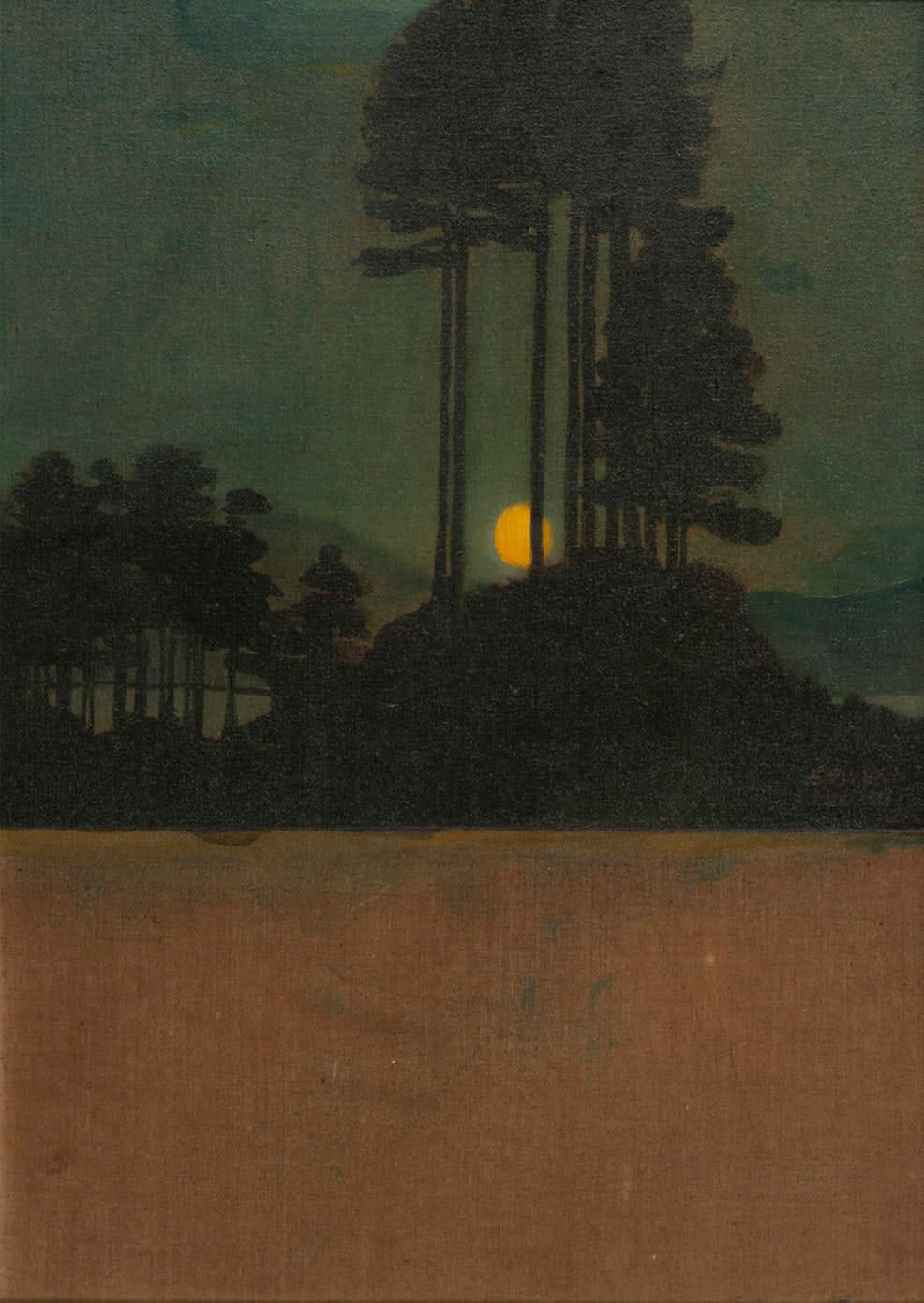Edward Steichen
Lake George, 1904
Oil on canvas laid to board
14 x 10 1/4 inches; Frame 18 1/4 x 14 1/4 inches
Signed and dated lower right.
Inscription and small drawing by Steichen, as well as various gallery labels verso.
Signed and dated lower right.
Inscription and small drawing by Steichen, as well as various gallery labels verso.
Further images
This rare painting by Edward Steichen was created during an important year of the artist's long and outsized career, 1904, and demonstrates his remarkable skill in depicting one of his...
This rare painting by Edward Steichen was created during an important year of the artist's long and outsized career, 1904, and demonstrates his remarkable skill in depicting one of his seminal, reoccurring motifs - "the romantic and mysterious quality of moonlight,” as he wrote in his autobiography.
In the early 1900s, inspired by his visits to the Lake George home of Alfred Stieglitz, Steichen created a number of crepuscular landscapes, often with a lake, a row of trees, and the glow of the moon somewhere in the distance. During this time, Steichen investigated the media of painting and photography symbiotically. The intimate scale and atmospheric quality of his paintings recall contemporaneous bichromate prints, such as his seminal work “The Pond - Midnight” and “Midnight, Lake George,” both of which were executed the same year as the present painting.
Steichen ultimately concluded painting to be an obstacle that prevented his full-time dedication to photography. Around 1923, as a symbolic purge, he destroyed most of his backlog of canvases in a bonfire at his home and garden in Voulangis, France. As he wrote, "it was a confirmation of my faith in photography, and the opening of a whole new world to me." He rejected the soft-focus aesthetics of Pictorialism around this time as well, committing himself instead to only shoot “sharp, clear pictures,” like his portrait work for Condé Nast and other Modernist endeavors.
Extant paintings usually still exist because they were given out for one reason or another. This one, executed in October of 1904, was gifted to Dr. Gustave Eckstein, who had treated Steichen for Typhoid at the New York Presbyterian Hospital earlier that year. The painting is inscribed to Eckstien as “an especial souvenir of my "Icecreamtyphoiditus.” Reading like a line by E.E. Cummings, Steichen is perhaps humorously alluding to the sweet treat as the source of his illness, as Typhoid can thrive in cold food.
Exhibited: Hirshl and Adler; “From Tonalism to Modernism: The paintings of Eduard J. Steichen,” at the Federal Reserve Board Building, Washington D.C., 1988.
In the early 1900s, inspired by his visits to the Lake George home of Alfred Stieglitz, Steichen created a number of crepuscular landscapes, often with a lake, a row of trees, and the glow of the moon somewhere in the distance. During this time, Steichen investigated the media of painting and photography symbiotically. The intimate scale and atmospheric quality of his paintings recall contemporaneous bichromate prints, such as his seminal work “The Pond - Midnight” and “Midnight, Lake George,” both of which were executed the same year as the present painting.
Steichen ultimately concluded painting to be an obstacle that prevented his full-time dedication to photography. Around 1923, as a symbolic purge, he destroyed most of his backlog of canvases in a bonfire at his home and garden in Voulangis, France. As he wrote, "it was a confirmation of my faith in photography, and the opening of a whole new world to me." He rejected the soft-focus aesthetics of Pictorialism around this time as well, committing himself instead to only shoot “sharp, clear pictures,” like his portrait work for Condé Nast and other Modernist endeavors.
Extant paintings usually still exist because they were given out for one reason or another. This one, executed in October of 1904, was gifted to Dr. Gustave Eckstein, who had treated Steichen for Typhoid at the New York Presbyterian Hospital earlier that year. The painting is inscribed to Eckstien as “an especial souvenir of my "Icecreamtyphoiditus.” Reading like a line by E.E. Cummings, Steichen is perhaps humorously alluding to the sweet treat as the source of his illness, as Typhoid can thrive in cold food.
Exhibited: Hirshl and Adler; “From Tonalism to Modernism: The paintings of Eduard J. Steichen,” at the Federal Reserve Board Building, Washington D.C., 1988.



![[New Age], Large Collection of Printed Matter Related to Numerous Mystical, Metaphysical and Spiritualist Groups in the Midwest and Elsewhere,...](https://artlogic-res.cloudinary.com/w_150,h_150,c_fill,f_auto,fl_lossy,q_auto/artlogicstorage/dollc/images/view/8676a2cd9c451fd76bda8f53746c6e5dj/daniel-oliver-edward-steichen-lake-george-1904.jpg)
![[New Age], Large Collection of Printed Matter Related to Numerous Mystical, Metaphysical and Spiritualist Groups in the Midwest and Elsewhere,...](https://artlogic-res.cloudinary.com/w_150,h_150,c_fill,f_auto,fl_lossy,q_auto/artlogicstorage/dollc/images/view/72f25461483f2c5b5a701680801370b4j/daniel-oliver-edward-steichen-lake-george-1904.jpg)
![[New Age], Large Collection of Printed Matter Related to Numerous Mystical, Metaphysical and Spiritualist Groups in the Midwest and Elsewhere,...](https://artlogic-res.cloudinary.com/w_150,h_150,c_fill,f_auto,fl_lossy,q_auto/artlogicstorage/dollc/images/view/6458e0b5ab006a3540d61701e0a7a837j/daniel-oliver-edward-steichen-lake-george-1904.jpg)